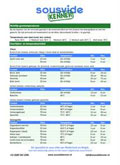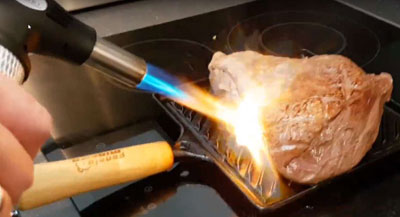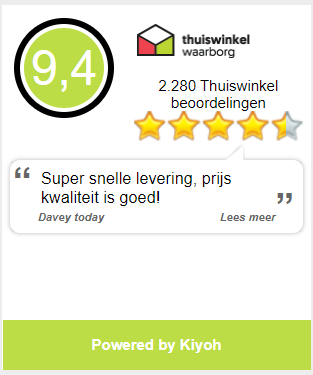Frequently Asked Questions about Sous Vide (FAQ)
Sous-vide is super populair en we kunnen ons goed voorstellen dat je vragen hebt. In deze FAQ (veelgstelde vragen) vind je antwoord op heel veel vragen die we krijgen van onze klanten en vanuit onze sous-vide community. Lees dus snel verder!
Below we answer frequently asked questions about sous-vide cooking. Don't know yet what sous vide is? Then first read our article "What is sous-vide?" .
Frequently asked questions about Sous Vide cooking
Click on the question below (link) to go directly to the answer.
- Is sous-vide cooking safe (bacteria) ?
- Isn't cooking in plastic bags harmful to your health ?
- Do I have to season dishes differently with sous-vide preparation ?
- What temperatures and cooking times should I use ?
- How long can I keep food after sous-vide cooking ?
- How can I reheat dishes ?
- Should I add salt before or after sous-vide cooking ?
- Are there ways to speed up the sous-vide cooking process ?
- How do I get that beautiful brown color/crust after sous-vide ?
- Why do I have to log data (HACCP for catering) ?
1. Is sous-vide cooking safe (bacteria)?
Sous-vide cooking is very safe, but can also be very unsafe. Of course, it starts with fresh products, working very cleanly in the kitchen and using a good vacuum. So only vacuum very cold products. You don't have to worry so much about preparations above a core temperature of 62 °C. Briefly cooked products above 52 °C that are eaten immediately are often no problem.
The risks are in long preparations below 62 °C and all preparations below 52 °C. Salmon, for example, is fantastic at 45 °C, but only use top quality salmon and work very cleanly. It is best to surface pasteurize meat that is cooked around that temperature.
2. Isn't cooking in plastic bags harmful to your health?
All vacuum bags and vacuum films in our webshop are 100% suitable for the relatively low temperatures of sous-vide and are also tasteless and odorless. The vacuum bags and films are tested with, among other things, water, alcohol and fatty acids at different temperatures and times, after which they are certified according to the highest European standards. All our vacuum bags are also free of BPAs and other plasticizers, and do not contain any chemicals that are harmful to health or (adversely) affect the taste. Your sous-vide dish will therefore not be contaminated with unpleasant substances and flavors.
In fact, vacuum cooking in sealed bags preserves all the juices of the product (no weight loss) and allows you to enjoy optimal taste and all the healthy vitamins and minerals the product contains.
3. Do I have to season dishes differently with sous-vide preparation?
Many flavors and aromas escape or dilute during classic preparations. Aroma substances practically do not evaporate during sous-vide cooking. So, for example, you need to add less herbs.
4. What temperatures and cooking times should I use?
 Many lists on the internet indicate different times and temperatures. That's quite confusing. Equipment suppliers often set very high temperatures for safety reasons. Top chefs often sit very low, which can pose risks.
Many lists on the internet indicate different times and temperatures. That's quite confusing. Equipment suppliers often set very high temperatures for safety reasons. Top chefs often sit very low, which can pose risks.
Yet many lists are correct, although you will of course get a slightly different result with different choices. That is why it is important to find out what you consider a good result. That is why we always recommend logging: writing down your choices and your opinion about the outcome. Frames often assume an average thickness. Thinner products are ready sooner, thicker or folded products take much longer.
At SousvideKenner you will receive iEvery order of €39 or more receives our unique sous-vide table with temperatures and times for most dishes for free. This table has been compiled with the utmost care for the best results and contains times and temperatures for almost all products.
Preparing sous vide for far too long almost never happens. But there are limits. An entrecote is no longer nice and firm after 20 hours. And some vegetables can lose their color.
There is a difference between cooking and letting it soften. Most preparations of vegetables, fish, eggs and meat, for example, are ready when the product is at the correct core temperature. If that is the case, you can let it cook for another 1 or 2 hours just to be sure, but that makes no sense: done is done. Meat (or octopus, for example) with a lot of connective tissue needs much longer: 6 to 24 hours. The meat becomes softer and smoother as long as you stay below 90 °C.
This process is of course much faster at a higher temperature. So you can find 2 recipes for a brisket: for example, 22 hours at 61 °C and 7 hours at 90 °C. Both give good results, but only once you have made both recipes can you make a good choice.
5. How long can I store food after sous-vide cooking?
You can only refrigerate products that have been above 55 °C core temperature. If you work with fresh and hygienic items, you can pasteurize most of them. You can then keep them well cooled in a vacuum for 3 to 4 weeks.
For example, pasteurization can be done for 16 minutes at 60 °C or 5 minutes at 65 °C. Please note: the time only starts when the core temperature is reached. Not all dishes are suitable for pasteurization: fish and red meat, for example, are almost always eaten immediately.
6. How can I reheat (regenerate) dishes?
It is best to regenerate sous-vide again at the previously used temperature. This is a good idea for very long preparations such as whole pulled pork. You won't always make any progress with short preparations: it will take you twice.
You can freeze products prepared sous vide and place them in water to reheat them. The process then takes quite a long time and consumes a lot of electricity. Thawing it in the refrigerator may be a more logical idea.
You can also color cooled products directly at a high temperature. The actual heating must then be done at a low temperature again. Products retain moisture very well during sous-vide preparations. If you regenerate at too high a temperature, vegetables, for example, will release that moisture. And that's not fun.
Please note: you can only refrigerate products that have been above 55 °C core temperature. The rest should be served immediately. Example: Cook duck breast for 70 minutes at 57 °C and cool quickly. The next day, fry it cold on the cut fat side and let it become crispy. Brown the other side briefly in the fat and then return it to a core temperature of 55 to 57 °C in the oven at 70 °C.
7. Should I add salt before or after sous-vide cooking?
Popularly, you extract moisture by adding salt. However, tests show that salt retains moisture. In fact, by wet brining you add moisture! It is also nice to see the salt IN your product and not just ON your product. Pre-salted products are therefore tastier.
The structure may change slightly, especially if you cool fish or meat after cooking and store it for a long time. Meat can then get a bit of a hammy structure, which not everyone likes.
1 to 1.5% salt of the product weight is the standard. The more other seasonings you use, the less salt you need to use. Especially if seasonings also contain salt such as soy sauce or fish sauce.
8. Are there ways to speed up the sous-vide process?
Yes, there are a few methods for that! The purpose of sous-vide is to ensure that the product has reached the correct temperature, right down to the core. You can use a higher starting temperature of up to 4 to 5 °C higher. That doesn't seem like much, but on a small steak it's a lot. It will be ready about fifteen minutes faster if you preheat your sous-vide bath to 55 °C and set it to 50 °C when you put the steak in it. The water temperature drops briefly and you save time. The product heats up faster to the core at a higher starting temperatureperature because you have taken a lead.
Even larger products that need to cook for hours can even be heated slightly higher for half an hour or an hour before setting the temperature correctly. This allows you to save an hour, for example.
However, the fastest way is to use a sous-vide thermometer. In combination with sous-vide tape you measure the core temperature, so you never have to spend too long. An additional advantage is that you can now heat your water or steam 2 to 3 °C higher than the desired core temperature. You remove your product at exactly the right time and it does not continue cooking because the difference with the ambient temperature is very small. This really saves time!
Letting a steak reach 50 °C without a sous-vide thermometer is often done for an hour to be on the safe side. Bringing the same steak to 50 °C at 53 °C with a sous-vide thermometer takes half an hour!
9. How do I get that beautiful brown color/crust after sous-vide?
 A customer once put it hilariously well: "After sous-vide, my piece of meat looks like a bleached bog body." Cooked meat is not a particularly appetizing sight indeed. Fortunately, there are several ways to get that beautiful brown, crispy crust on your meat.
A customer once put it hilariously well: "After sous-vide, my piece of meat looks like a bleached bog body." Cooked meat is not a particularly appetizing sight indeed. Fortunately, there are several ways to get that beautiful brown, crispy crust on your meat.
It is almost always wise to pat the product dry. You can then use all kinds of preparations. For example, barbecuing, grilling, frying in a pan or coloring with a gas burner (also called a chef's burner or crème Brûlée burner).
The goal is almost always to achieve the Maillard reaction : the product becomes tastier, more complex and more beautiful. Always ensure that the product is completely dry before applying grease and heat. Water is Maillard's enemy and makes the coloring process take much longer. This means that the product can easily become too hot and continue cooking. Also be careful not to burn the crust with the extremely hot flame (1300ºC or even higher) of gas burners, as this not only ruins the taste but produces carcinogens that are bad for your health.
For steak, for example, you can also let the meat cool a few degrees before putting it in the pan. The great thing about sous-vide is that meat hardly needs to rest after coloring, a few minutes is enough. Never let fried meat rest on a plate or wrapped in aluminum foil, as the beautiful crust will disappear again. On a rack in an oven at 65 to 75 °C is nice, preferably without air circulation.
10. Why do I have to log data (HACCP for catering)?
There are only 2 options after preparation. Option 1: You loved the result and want to reproduce it next time. In that case it is nice if you have noted all times, temperatures, thicknesses and flavorings. Option 2: you want to improve your result next time. In that case too, it is great if you have noted everything down, so that you can make targeted adjustments. A wise chef writes down everything when test cooking a dish.
In addition, there are also special sous-vide machines that, in combination with a core temperature sensor, make logging all important data very easy. An example of this is the Fusionchef Diamond series of professional sous-vide machines for the catering industry.



